

Christian eschatology. Christian eschatology is a major branch of study within Christian theology.
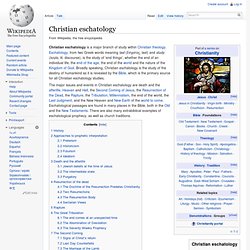
Afterlife. Ancient Egyptian papyrus depicting the journey into the afterlife.
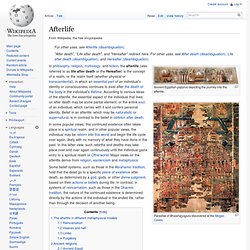
Paradise of Bhaishajyaguru discovered at the Mogao Caves. [edit] In metaphysical models, theists generally believe some sort of afterlife awaits people when they die. Members of some generally non-theistic religions such as Buddhism, tend to believe in an afterlife, but without reference to a God. The Sadducees were an ancient Jewish sect that generally believed that there was a God but no afterlife. Many religions, whether they believe in the soul's existence in another world like Christianity, Islam and many pagan belief systems, or in reincarnation like many forms of Hinduism and Buddhism, believe that one's status in the afterlife is a reward or punishment for their conduct during life. Reincarnation[edit] Reincarnation refers to an afterlife concept found among Hindus, Buddhists, Jains, Sikhs, Rosicrucians, Theosophists, Spiritists, and Wiccans.
Christian views on Hell. Christian views on hell generally hold it to be place or a state in which the souls of the damned suffer the consequences of their sins eternally.
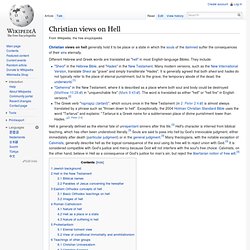
Different Hebrew and Greek words are translated as "hell" in most English-language Bibles. They include: "Sheol" in the Hebrew Bible, and "Hades" in the New Testament. Many modern versions, such as the New International Version, translate Sheol as "grave" and simply transliterate "Hades". It is generally agreed that both sheol and hades do not typically refer to the place of eternal punishment, but to the grave, the temporary abode of the dead, the underworld.[1]"Gehenna" in the New Testament, where it is described as a place where both soul and body could be destroyed (Matthew 10:28) in "unquenchable fire" (Mark 9:43).
Jewish background[edit] Hell (on the right) is portrayed in this 16th-century Hieronymus Bosch painting. In ancient Jewish belief, the dead were consigned to Sheol or the grave, to which all were sent indiscriminately (cf. Hades. Heaven (Christianity) Last Judgment. Second Coming. Greek icon of Second Coming, c.1700 In Christianity, the Second Coming, sometimes called the second advent of Christ or the parousia, is the anticipated return of Jesus to Earth.
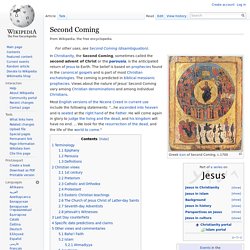
The belief is based on prophecies found in the canonical gospels and is part of most Christian eschatologies. The coming is predicted in biblical messianic prophecies. Views about the nature of Jesus' Second Coming vary among Christian denominations and among individual Christians. Most English versions of the Nicene Creed in current use include the following statements: "...he ascended into heaven and is seated at the right hand of the Father.
Terminology[edit] Several different terms are used to refer to the Second Coming of Christ: Resurrection of the dead. A resurrection of the dead is a common component of a number of eschatologies, most commonly in Christian, Islamic, Jewish and Zoroastrian eschatology.

Millennialism. This is an overview of both Christian and non-Christian Millennialism.
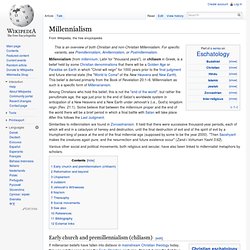
For specific variants, see Premillennialism, Amillennialism, or Postmillennialism. Millennialism (from millennium, Latin for "thousand years"), or chiliasm in Greek, is a belief held by some Christian denominations that there will be a Golden Age or Paradise on Earth in which "Christ will reign" for 1000 years prior to the final judgment and future eternal state (the "World to Come" of the New Heavens and New Earth). This belief is derived primarily from the Book of Revelation 20:1–6. Millennialism as such is a specific form of Millenarianism. Among Christians who hold this belief, this is not the "end of the world", but rather the penultimate age, the age just prior to the end of Satan's worldwide system in anticipation of a New Heavens and a New Earth under Jehovah's (i.e., God's) kingdom reign (Rev. 21:1).
Similarities to millennialism are found in Zoroastrianism. Early church and premillennialism (chiliasm)[edit] Rapture. Great Tribulation. The Great Tribulation (Greek: θλίψις μεγάλη, thlipsis megalē) refers to tumultuous events that are described during the "signs of the times", first mentioned by Jesus in the Olivet discourse.[1] The Great Tribulation is also referenced in the Book of Revelation.[2] Biblical description[edit] Within the ninth chapter of the Book of Revelation, the Tribulation is described as follows: Views of the Tribulation[edit] Futurist view[edit] According to Dispensationalists who hold the futurist view, the Tribulation is thought to occur before the Second Coming of Jesus and during the End Times.
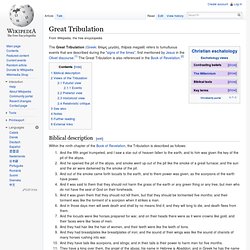
Events[edit] Among futurists there are differing views about what will happen to Christians during the Tribulation: In pretribulationism and midtribulationism, the Rapture and the Second Coming (or Greek, par[a]ousia) of Christ are separate events, while in post-tribulationism the two events are identical or simultaneous.
Preterist view[edit] Historicist view[edit] Relativistic critique[edit] Elijah. In Judaism Elijah's name is invoked at the weekly Havdalah ritual that marks the end of Shabbat, and Elijah is invoked in other Jewish customs, among them the Passover seder and the Brit milah (ritual circumcision).

He appears in numerous stories and references in the Haggadah and rabbinic literature, including the Babylonian Talmud. In Christianity the New Testament describes how both Jesus and John the Baptist are compared with Elijah and on some occasions thought by some to be manifestations of Elijah, and Elijah appears with Moses during the Transfiguration of Jesus. In Islam the Qur'an describes Elijah as a great and righteous prophet of God and one who powerfully preached against the worship of Ba'al. Elijah is also a figure in various Christian folk traditions, often identified with earlier pagan thunder or sky gods.
Biblical narratives and historical background[edit] Map of Israel as it was in the 9th century BC. As King, Ahab exacerbated these tensions. Book of Enoch. The older sections (mainly in the Book of the Watchers) are estimated to date from about 300 B.C., and the latest part (Book of Parables) probably was composed at the end of the first century B.C.[2] It is wholly extant only in the Ge'ez language, with Aramaic fragments from the Dead Sea Scrolls and a few Greek and Latin fragments.
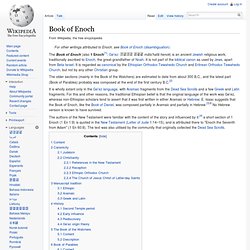
For this and other reasons, the traditional Ethiopian belief is that the original language of the work was Ge'ez, whereas non-Ethiopian scholars tend to assert that it was first written in either Aramaic or Hebrew; E. Isaac suggests that the Book of Enoch, like the Book of Daniel, was composed partially in Aramaic and partially in Hebrew.[3]:6 No Hebrew version is known to have survived.